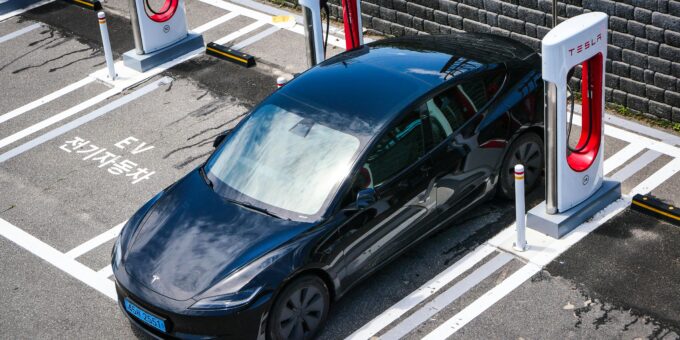
Owning an electric vehicle (EV) is an eco-friendly and cost-effective way to drive, but understanding how to charge your EV at home is crucial to maximizing its benefits. Home charging is one of the most convenient and affordable ways to power your car, but it requires some planning and knowledge of the available options.
This guide provides everything you need to know about home charging for your electric vehicle, including the types of chargers, installation requirements, costs, and tips for optimizing your charging routine.
How Does EV Home Charging Work?
Charging your electric vehicle at home is straightforward. All EVs come with a charging cable that allows you to plug your car into a power source. Once connected, the car’s battery charges by drawing electricity from your home’s power grid.
The charging process is managed by an onboard charger inside the vehicle, which converts AC (alternating current) electricity from your home into DC (direct current) electricity to power the battery. The speed of charging depends on the type of charger you use and the capacity of your vehicle’s battery.
Types of EV Chargers for Home Use
There are three main types of chargers to consider:
- Level 1 Charger:
- Uses a standard 120-volt household outlet.
- Ideal for drivers with short commutes or low daily mileage.
- Charging Speed: Adds about 3–5 miles of range per hour.
- No installation costs, but charging is slow.
- Level 2 Charger:
- Uses a 240-volt outlet or a dedicated charging station.
- Charging Speed: Adds 20–40 miles of range per hour.
- Requires professional installation and is the most popular option for home charging.
- DC Fast Charger:
- Typically found at public charging stations.
- Uses 480 volts or higher to charge extremely fast.
- Rarely installed in homes due to high costs and electrical requirements.
What Is a Level 1 Charger?
A Level 1 charger is the simplest and most accessible option, as it works with any standard 120-volt household outlet. While it’s convenient and requires no additional setup, it’s also the slowest charging option.
Pros:
- No installation costs.
- Perfect for drivers with minimal daily mileage needs.
Cons:
- Extremely slow charging, taking 20–50 hours to fully charge most EVs.
- Limited for long-distance travel or high-mileage drivers.
What Is a Level 2 Charger?
Level 2 chargers are the go-to choice for most EV owners. They require a 240-volt outlet, similar to what is used for large appliances like dryers. Level 2 chargers significantly reduce charging time, making them more practical for daily use.
Pros:
- Much faster charging (4–6 hours for a full charge).
- Ideal for frequent drivers.
- Can be equipped with smart features, like energy monitoring and scheduling.
Cons:
- Requires professional installation.
- Higher upfront costs compared to Level 1 chargers.
How to Install an EV Charger at Home
Installing a Level 2 charger requires some preparation and professional assistance. Here’s a step-by-step guide:
- Check Your Electrical System: Ensure your home’s electrical panel can support a 240-volt outlet.
- Hire a Licensed Electrician: An electrician can install the outlet or hardwire the charger.
- Obtain Permits (if required): Check local regulations and secure any necessary permits.
- Install the Charger: Mount the charging station on a wall or stand in your garage or driveway.
- Test the System: Verify that the charger works and charges your vehicle efficiently.
How Much Does It Cost to Charge an EV at Home?
The cost to charge your EV at home depends on your electricity rate and the size of your car’s battery.
Example Calculation:
- Electricity Rate: $0.15 per kilowatt-hour (kWh).
- Battery Size: 60 kWh.
- Charging Cost: 60 kWh × $0.15 = $9 for a full charge.
Compare this to the cost of gasoline, and you’ll see why home charging is so cost-effective.
Ways to Lower Charging Costs
- Time-of-Use Rates: Charge your car during off-peak hours when electricity rates are lower.
- Install Solar Panels: Generate your own renewable energy to charge your car.
- Smart Chargers: Use scheduling features to charge at the cheapest times.
EV Charging Safety Tips
- Always use certified charging equipment.
- Keep your charger and outlet free from water and debris.
- Avoid using extension cords for EV charging.
- Regularly inspect cables for wear and tear.
FAQs About Charging Your Electric Vehicle at Home
How long does it take to install a Level 2 charger?
Can I charge my EV in the rain?
What’s the lifespan of a home EV charger?
Do I need a dedicated circuit for my charger?
Can I use solar energy to charge my EV?
Charging your electric vehicle at home is one of the most convenient and cost-effective ways to power your car. By understanding the types of chargers, installation requirements, and ways to optimize your charging routine, you can enjoy a seamless EV ownership experience.
Take the first step today by exploring your options for Level 2 chargers, reviewing your home’s electrical setup, and consulting with a licensed electrician. With the right setup, you’ll enjoy the convenience of waking up every morning to a fully charged car.